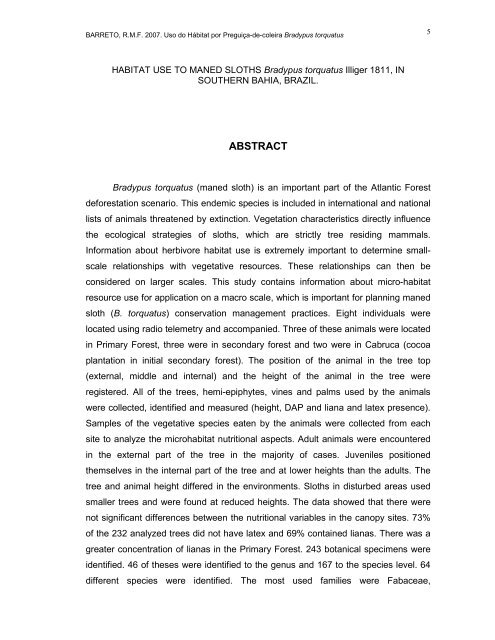USO DO HÁBITAT PELA PREGUIÇA-DE-COLEIRA ... - CNCFlora
USO DO HÁBITAT PELA PREGUIÇA-DE-COLEIRA ... - CNCFlora
USO DO HÁBITAT PELA PREGUIÇA-DE-COLEIRA ... - CNCFlora
Create successful ePaper yourself
Turn your PDF publications into a flip-book with our unique Google optimized e-Paper software.
BARRETO, R.M.F. 2007. Uso do Hábitat por Preguiça-de-coleira Bradypus torquatus<br />
HABITAT USE TO MANED SLOTHS Bradypus torquatus Illiger 1811, IN<br />
SOUTHERN BAHIA, BRAZIL.<br />
ABSTRACT<br />
Bradypus torquatus (maned sloth) is an important part of the Atlantic Forest<br />
deforestation scenario. This endemic species is included in international and national<br />
lists of animals threatened by extinction. Vegetation characteristics directly influence<br />
the ecological strategies of sloths, which are strictly tree residing mammals.<br />
Information about herbivore habitat use is extremely important to determine smallscale<br />
relationships with vegetative resources. These relationships can then be<br />
considered on larger scales. This study contains information about micro-habitat<br />
resource use for application on a macro scale, which is important for planning maned<br />
sloth (B. torquatus) conservation management practices. Eight individuals were<br />
located using radio telemetry and accompanied. Three of these animals were located<br />
in Primary Forest, three were in secondary forest and two were in Cabruca (cocoa<br />
plantation in initial secondary forest). The position of the animal in the tree top<br />
(external, middle and internal) and the height of the animal in the tree were<br />
registered. All of the trees, hemi-epiphytes, vines and palms used by the animals<br />
were collected, identified and measured (height, DAP and liana and latex presence).<br />
Samples of the vegetative species eaten by the animals were collected from each<br />
site to analyze the microhabitat nutritional aspects. Adult animals were encountered<br />
in the external part of the tree in the majority of cases. Juveniles positioned<br />
themselves in the internal part of the tree and at lower heights than the adults. The<br />
tree and animal height differed in the environments. Sloths in disturbed areas used<br />
smaller trees and were found at reduced heights. The data showed that there were<br />
not significant differences between the nutritional variables in the canopy sites. 73%<br />
of the 232 analyzed trees did not have latex and 69% contained lianas. There was a<br />
greater concentration of lianas in the Primary Forest. 243 botanical specimens were<br />
identified. 46 of theses were identified to the genus and 167 to the species level. 64<br />
different species were identified. The most used families were Fabaceae,<br />
5
















